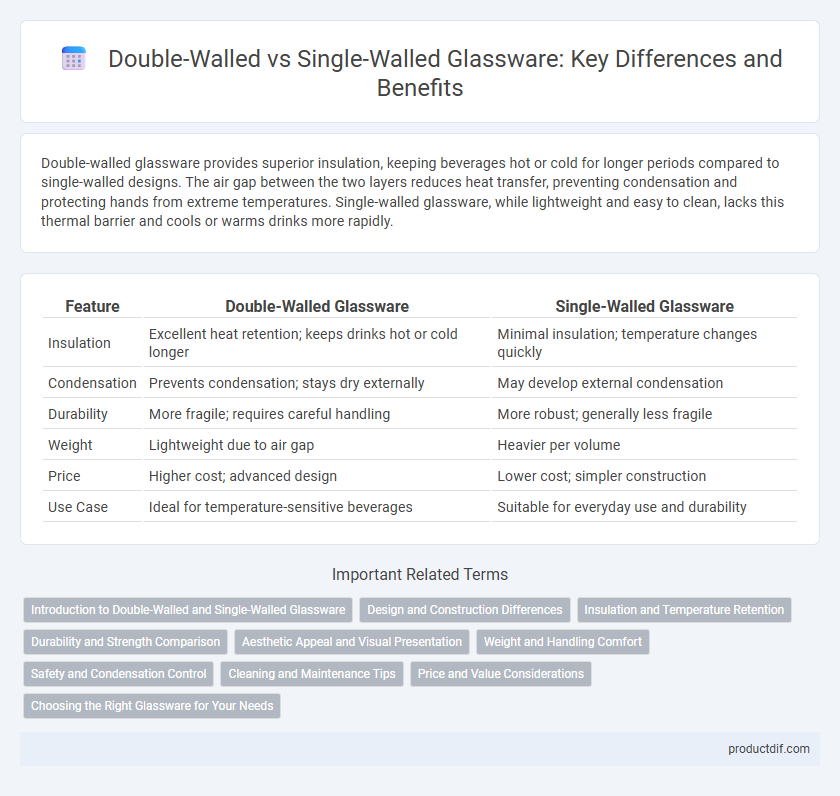Double-walled glassware provides superior insulation, keeping beverages hot or cold for longer periods compared to single-walled designs. The air gap between the two layers reduces heat transfer, preventing condensation and protecting hands from extreme temperatures. Single-walled glassware, while lightweight and easy to clean, lacks this thermal barrier and cools or warms drinks more rapidly.
Table of Comparison
| Feature | Double-Walled Glassware | Single-Walled Glassware |
|---|---|---|
| Insulation | Excellent heat retention; keeps drinks hot or cold longer | Minimal insulation; temperature changes quickly |
| Condensation | Prevents condensation; stays dry externally | May develop external condensation |
| Durability | More fragile; requires careful handling | More robust; generally less fragile |
| Weight | Lightweight due to air gap | Heavier per volume |
| Price | Higher cost; advanced design | Lower cost; simpler construction |
| Use Case | Ideal for temperature-sensitive beverages | Suitable for everyday use and durability |
Introduction to Double-Walled and Single-Walled Glassware
Double-walled glassware features two layers of glass with an insulating air pocket that enhances thermal retention and prevents condensation. Single-walled glassware consists of a single layer of glass, offering a lightweight design but less temperature insulation. The insulating properties of double-walled glassware make it ideal for maintaining beverage temperature longer compared to single-walled options.
Design and Construction Differences
Double-walled glassware features two layers of glass separated by an insulating air gap that enhances thermal retention and prevents condensation, while single-walled glassware consists of a single layer that offers minimal insulation. The design of double-walled glassware often involves precision engineering to ensure durability and a lightweight feel despite its complex construction. Single-walled glassware prioritizes simplicity and clarity, making it easier to clean but less effective at maintaining beverage temperature.
Insulation and Temperature Retention
Double-walled glassware features an insulating layer of air trapped between two glass walls, enhancing temperature retention by minimizing heat transfer and condensation. Single-walled glassware lacks this barrier, causing faster heat exchange and reduced insulation, leading to quicker cooling or warming of beverages. Optimal temperature maintenance in drinkware depends heavily on the presence of double-wall insulation technology.
Durability and Strength Comparison
Double-walled glassware features two layers of glass separated by an insulating air pocket, enhancing durability and resistance to thermal stress compared to single-walled glass. Single-walled glass is more prone to cracking or breaking under sudden temperature changes due to its single layer construction. The robust structure of double-walled designs offers superior strength and longer lifespan, making them ideal for frequent use and temperature variations.
Aesthetic Appeal and Visual Presentation
Double-walled glassware offers a unique aesthetic appeal with its floating liquid effect, enhancing the visual presentation by creating an illusion of suspended beverages. Single-walled glasses provide a classic and transparent look, allowing the true color and texture of drinks to be fully appreciated without distraction. The elegant design of double-walled glass adds a modern sophistication that elevates the overall drinking experience.
Weight and Handling Comfort
Double-walled glassware offers enhanced insulation while typically maintaining a lighter weight compared to single-walled counterparts, improving handling comfort during prolonged use. The air gap between layers in double-walled designs reduces heat transfer, allowing for cooler exterior surfaces and easier grip stability. Single-walled glassware often feels heavier and transfers temperature directly, which can lead to discomfort when handling hot or cold beverages.
Safety and Condensation Control
Double-walled glassware enhances safety by providing insulation that reduces the risk of burns from hot beverages, while single-walled glass often becomes too hot to handle. The double-wall design effectively controls condensation by creating an air gap that prevents moisture buildup on the outer surface, keeping tables and hands dry. In contrast, single-walled glassware tends to accumulate condensation, increasing the risk of slips and surface damage.
Cleaning and Maintenance Tips
Double-walled glassware requires gentle hand washing with mild detergent to prevent damage to the insulating layer, avoiding abrasive scrubbers that can compromise the seal. Single-walled glassware is generally dishwasher-safe but still benefits from careful cleaning to maintain clarity and prevent etching. Regular thorough drying and avoiding extreme temperature changes extend the lifespan of both glass types.
Price and Value Considerations
Double-walled glassware generally costs more due to its advanced insulation technology, offering superior temperature retention and reduced condensation compared to single-walled options. Single-walled glassware is more affordable but lacks thermal insulation, making it less effective for maintaining beverage temperature over time. Consumers seeking long-term value often prefer double-walled designs for their durability and enhanced drinking experience despite the higher initial investment.
Choosing the Right Glassware for Your Needs
Double-walled glassware provides superior insulation by creating an air pocket between two layers of glass, maintaining beverage temperature longer and preventing condensation. Single-walled glassware offers a classic design with lighter weight but lacks thermal insulation, making it ideal for quick consumption or serving room-temperature drinks. Selecting the right option depends on your preference for temperature retention, durability, and style requirements.
Double-walled vs Single-walled Infographic

 productdif.com
productdif.com